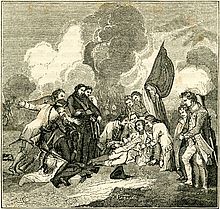Up Close: Three-Way Collaboration in Frost’s Pictorial History
What were the effects of these two-way collaborations between publisher and historian, historian and artist, and artist and publisher respectively on Frost’s Pictorial History as a literary production? Sometimes they resulted in tightly integrated historical passages in which text, illustrations, and bookmaking were sutured together in seamless ways that explained why the volumes sold well (more than fifty thousand copies in its first year on the market). More often, however, they revealed disjunctures that betrayed the lack of a common or agreed-upon purpose among the various contributors to the work. In Frost’s Pictorial History of the United States there are frequent incompatibilities of layout, text, and illustrations that reveal how much at cross-purposes Walker, Frost and Croome were in their literary, visual and editorial approaches to historical subjects. As the following images and commentary reveal, the dysfunctional relationships among the three often led to inadequate depictions of history and some justifiable criticisms of the final product. Illustrator F. O. C. Darley, who had only a marginal affiliation with the project, came to view it as an impediment to his career. He noted (somewhat ungenerously given that he was an unproven student of Croome’s at the time) that he was “enticed into [the] project,” discovering only too late that the Frost’s Pictorial History of the United States was “an ambitious and pretentious” enterprise that “collapsed from a dearth of talent and skill.”[28]
Explore the following pages to highlight these collaborative relationships and examine the results up close.


